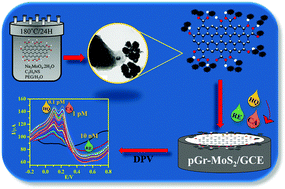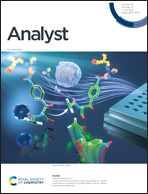Picomolar level electrochemical detection of hydroquinone, catechol and resorcinol simultaneously using a MoS2 nano-flower decorated graphene†
Abstract
Herein, a graphene-nano-molybdenum disulphide (pGr-MoS2), synthesized from pulverized graphite and using precursors of MoS2, was investigated for the electrochemical sensing of dihydroxy benzene isomers (DHBI): hydroquinone (HQ), catechol (CA), and resorcinol (RE). Interestingly, the material could sense the three isomers simultaneously, with well-defined peaks and an adequate potential difference between each peak. The detection limits (3σ method) of HQ, CA, and RE on the glassy carbon electrode (GCE) modified with pGr-MoS2 are 10−13, 10−12, and 10−8 M (i.e., 0.1 pM, 1 pM, and 10 nM), respectively, and are the lowest reported so far for the isomers. The pGr-MoS2/GCE exhibited selectivity towards DHBI, in the presence of other toxic contaminants and metal ions such as phenol, dinitrophenol, trinitrophenol, urea and glucose, Hg(II), Ca(II), Ni(II), Zn(II), Cu(II), Na(I) and K(I). A possible mechanism for this superior selectivity of pGr-MoS2 towards DHBI is discussed based on the structural properties of pGr-MoS2 with evidence. Further, the pGr-MoS2 sensor exhibited reproducibility (with six different electrodes), stability (≥90 days), and repeatability properties. The sensing performance was successfully demonstrated in real water samples such as ground-, tap-, and river- water spiked with HQ, CA, and RE.



 Please wait while we load your content...
Please wait while we load your content...